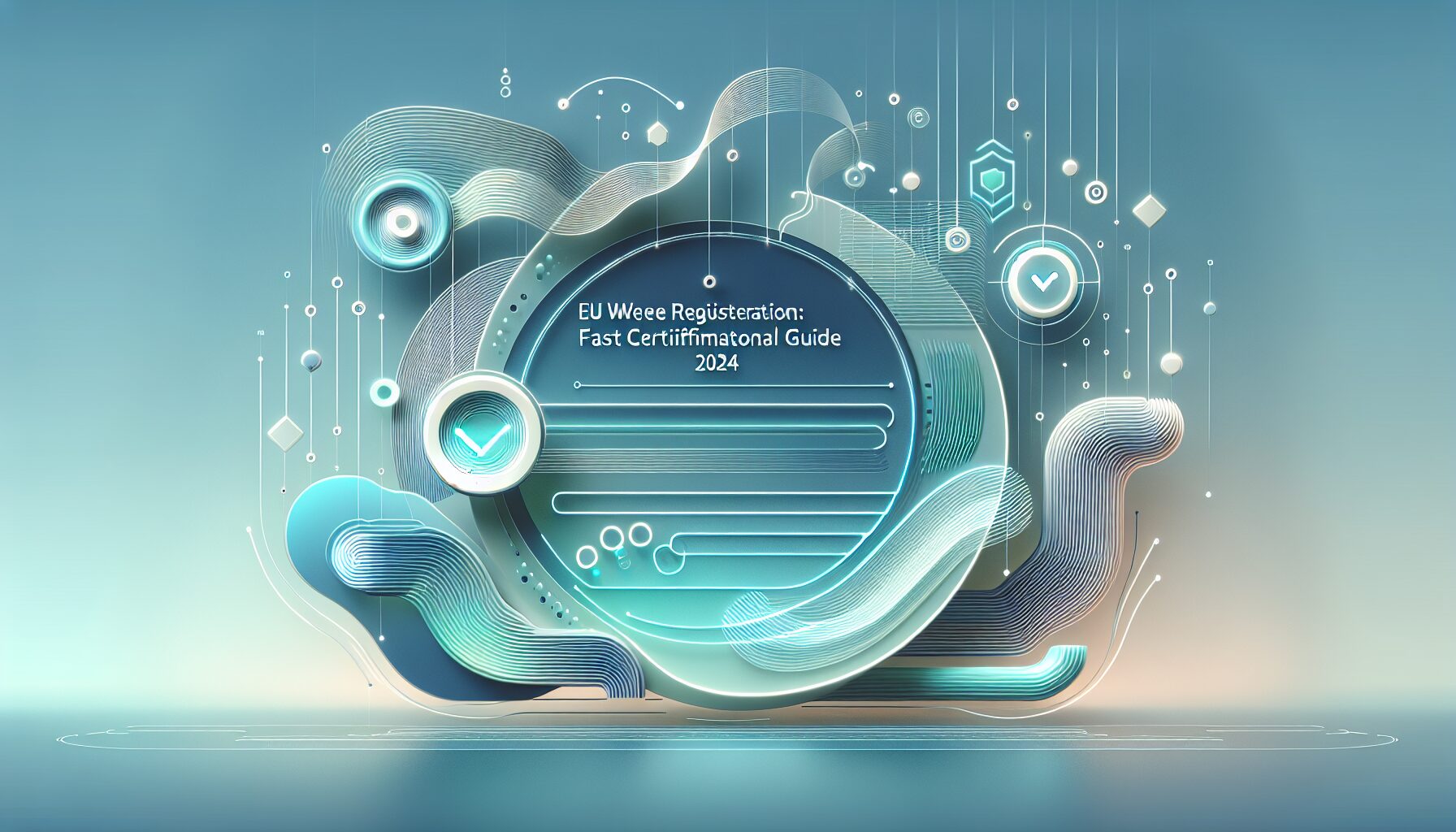About eldris
epr.eldris.ai leads the EPR sector, in fast, automated, AI Agent EU Complaince. LUCID Packaging, WEEE, and Battery Compliance for Brands, E-Commerce and Service based businesses expanding into the EU.
In This Article
- EU WEEE registration is mandatory for all EEE producers selling in the European Union.
- Each Member State has its own registration rules and compliance bodies.
- Proper documentation and scheme selection speed up registration.
- Using automation tools can simplify multi-country registration and reporting.
- Marketplaces are increasingly enforcing WEEE compliance with strict penalties for violations.
What Is EU WEEE Registration?
Understanding the WEEE Directive
EU WEEE registration refers to the mandatory compliance process that producers of electrical and electronic equipment (EEE) must follow under the Waste Electrical and Electronic Equipment (WEEE) Directive. This directive, established by the European Union, aims to reduce the environmental impact of electronic waste by promoting reuse, recycling, and proper disposal of EEE products.
The WEEE Directive (Directive 2012/19/EU) was created to establish the responsibilities of actors involved in the EEE lifecycle. Producers who place EEE onto the EU market are obligated to finance the collection, treatment, recovery, and environmentally sound disposal of WEEE. Therefore, without EU WEEE registration, companies cannot legally distribute EEE within any EU Member State.

Who Needs to Register for WEEE?
Producers, Importers & Online Sellers
EU WEEE registration is a requirement for all companies placing electrical or electronic equipment onto EU markets, regardless of whether the entity is located within or outside the Union. This includes traditional manufacturers, importers, distance sellers, and even online platforms facilitating the sale of such goods.
A “producer” under WEEE is defined as any person or business that:
- Manufactures and sells EEE under their own brand within the EU
- Resells equipment produced by others under their own name or trademark
- Imports or exports EEE into EU countries
- Sells EEE directly to consumers in the EU via distance communication (e.g., e-commerce)
If your business model involves cross-border selling into multiple EU countries, then you may need to register in every applicable Member State, further emphasising the value of a harmonised compliance strategy. In some cases, a local authorised representative may be required in order to meet national requirements.
“If you sell electronic products into any EU Member State, failing to complete EU WEEE registration could lead to legal penalties, market bans, or removal from leading platforms.”
Requirements for Fast WEEE Certification
Organisations seeking fast-track WEEE certification must understand and prepare required documentation early in the process. The following steps are crucial for obtaining EU WEEE registration without delay:
- Identify the correct product categories as per the WEEE Directive
- Select the relevant compliance scheme(s) in targeted national markets
- Provide company registration details including VAT, address, and contact point
- Register the brand(s) and models of EEE being placed on the market
- Declare annual volumes and expected quantities of products sold
Moreover, each Member State has its own registry, often with unique application forms and regulatory interpretations. Keeping these nuances in mind when completing registration ensures quicker approval and reduces the risk of administrative rejection. Businesses should consider partnering with local compliance specialists to submit accurate data in a timely manner.
Country-Specific WEEE Rules in the EU
While the WEEE Directive sets a unified framework, individual enforcement and execution differ significantly between countries. Germany, France, Italy, and Spain each maintain autonomous national registers and may levy differing collection targets, auditing procedures, or labelling requirements.
For example, in Germany, companies must register with the Stiftung EAR authority before shipping any units. France requires registration through approved Producer Responsibility Organisations (PROs) and mandates eco-modulation for certain product categories. Meanwhile, in Sweden, compliance includes fees based on historic vs. current sales volumes, and companies need to submit returns in the national language quarterly.
As a result, simply registering in one country does not offer pan-European compliance. EU WEEE registration must be approached on a country-to-country basis, with full documentation and an understanding of local nuances. This is where automation tools or consultancy partners become invaluable.
Steps to Register as an EU WEEE Producer
The process for EU WEEE registration can be divided into the following actionable phases:
- Assess Applicability: Determine whether the equipment you sell falls within the scope of the WEEE Directive.
- Identify National Obligations: Review Member State implementation rules where your products are sold.
- Select a Compliance Scheme: Choose a national or pan-EU collective compliance scheme, if applicable.
- Gather Documents: Submit business registration documentation, VAT details, and brand/product categorisation.
- Register Locally: Perform the official registration in each relevant country and obtain a producer registration number.
- Arrange Reporting Cycles: Setup systems to submit regular reports on EEE placed on the market and collected.
- Affix Labelling: Ensure your products bear the proper WEEE crossed-out wheeled bin symbol and registration info.
Without these formalities, access to physical marketplaces or even digital platforms may be at risk, especially as enforcement actions accelerate throughout the EU.
How to Choose a WEEE Compliance Scheme
One of the most important decisions in EU WEEE registration is selecting the right compliance scheme. Producer Responsibility Organisations (PROs) are entities authorised by Member States to assist companies in complying with their obligations.
When choosing a PRO, consider the following:
- Whether the scheme supports multiple product categories
- Cost structures and annual membership fees
- Support for multilingual documentation
- Experience handling cross-border cases
- Online registration and reporting capabilities
Firms engaged in multiple countries may prefer supranational schemes with harmonised services, but checking each scheme’s specific authority in each country remains essential. Some well-regarded schemes include ERP (European Recycling Platform) and Ecologic.
Documents Required for WEEE Certification
Efficient EU WEEE registration relies heavily on submitting complete and accurate documentation. The typical documents include:
- Company legal certificate or trade register extract
- VAT number and EORI number where applicable
- Proof of brand ownership or authorisation to distribute
- Product technical specifications and EEE categorisation
- Signatory form appointing a compliance scheme or authorised representative
These documents must be translated into the national language in certain jurisdictions. Missing information not only delays approvals but may lead to application rejection or retroactive non-compliance penalties.
How Marketplaces Enforce WEEE Compliance
Major marketplaces, including Amazon and eBay, now enforce EU WEEE registration as a prerequisite for listing EEE items in select countries. For instance, Amazon requires a valid registration number in Germany and France to activate listings.
Sellers are often required to submit proof of registration and ongoing fulfilment reports, failing which their EEE listings may be suspended or deactivated. Platforms also work with compliance verification tools to monitor adherence. Therefore, registering early and having documentation on file is crucial for uninterrupted sales operations.
Moreover, some platforms have integrated tools that allow upload of WEEE registration numbers on seller dashboards, making ongoing compliance more manageable.
Use of Automated Platforms for WEEE Registration
As regulatory complexity grows, automated platforms have emerged to simplify EU WEEE registration. These services assist with document submission, reporting, scheme selection, and national liaison in multiple languages.
Automation provides several advantages:
- Quicker response time for initial registration
- Auto-generated reports for national submission deadlines
- Translation support for national requirements
- Centralised dashboard for all EU markets
Providers such as ComplianceHub and EcoLogicAI offer tailored support depending on your sales volume and market scope. Learn more about EU EPR & Product Environmental Compliance
Common Mistakes in WEEE Registration
Despite the clarity of obligations, many businesses make errors during the EU WEEE registration process:
- Failing to register in every Member State where products are sold
- Choosing compliance schemes without understanding cost or scope
- Incorrect EEE categorisation leading to non-compliance reports
- Omitting mandatory product labelling
- Missing monthly or quarterly return filings
Unfortunately, these mistakes can result in penalties, legal consequences, product bans, or even permanent bans from online marketplaces. Early education, professional guidance, and automation tools reduce this risk dramatically. Read a related article
Conclusion: Achieving WEEE Compliance Fast
[CONCLUSION_CONTENT]
Navigating EU WEEE registration may appear daunting, but with the right preparation, it can be achieved rapidly. Understanding your legal obligations, selecting appropriate national compliance schemes, and properly submitting required documentation will streamline the process. Integrating automation platforms and avoiding common oversights ensures that EEE products reach the EU market without disruption. By embracing compliant, efficient practices now, businesses position themselves for long-term, sustainable success across European channels. Official EU WEEE producer obligations overview
Great guide on eu-weee-compliance-fast-registration-certification – Community Feedback
How do I register for WEEE in the EU?
To register for WEEE, you must apply with national authorities or an approved compliance scheme. Submit business documentation, product scope details, and fulfil reporting duties per country requirements.
Is WEEE compliance mandatory for all electronics sellers?
Yes, the WEEE Directive requires all producers selling electrical and electronic equipment in the EU to register and comply, regardless of business size or online/offline sales channel.
What documents are needed for WEEE certification?
Common documents include your business registration certificate, proof of EU presence or responsible person, product details by category, financial records, and eco-compliance evidence. Requirements vary by country.










